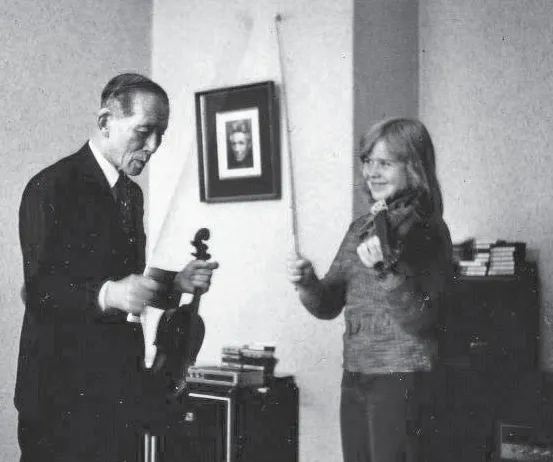![]()
5
Memories
I’ll never forget the first time I heard a group of Japanese children playing in real life. Despite all the TV coverage I’d seen, I was quite unprepared for the impact this performance would make on me. I was near tears as I watched a large group of students aged no more than nine playing Bach’s Concerto for Two Violins. As I remember the event even now, I have a lump in my throat.
I attended some Suzuki Method Teachers’ Conventions in Honolulu. I remember at one of these, sitting at dinner with a very international group. As far as I can recall, it included Professor William and Constance Starr from the US, Dr Honda from Japan and Dr Alfred Garson from Canada. We were entertained during dinner by a group of little Japanese violinists. It hit me suddenly what a heavy responsibility we have, guiding children. The group on stage trusted their teachers implicitly and had been taught to play beautiful music.
‘You could train a group of children, anywhere in the world, to do anything,’ I mused as I listened to Mozart. It was a very sobering and somewhat disturbing thought.
Looking at my old programmes, I notice that one of the young soloists at a Honolulu conference was a lad by the name of Haruo Goto. Haruo now teaches in Sydney.
Dr Garson told us about one of Suzuki’s early visits to Canada. Alfred had set up a lecture/demonstration. The visiting Japanese children performed a most difficult programme and then the audience was invited to ask Dr Suzuki some questions.
A nun rose and proceeded to explain her difficulties with teaching.
‘Professor Suzuki, I have a number of students,’ she said. ‘They don’t have good posture and I just can’t get them to hold the bow correctly. They never seem to be able to play a piece from memory; they just don’t have the confidence. They don’t play well in tune either. What should I do?’
Suzuki’s answer was immediate.
‘Pray to God,’ he said (as Alfred Garson reported).
Going to Japan
As soon as the Western music world became aware that hundreds of Japanese children played the violin, foreign teachers began to visit Dr Suzuki’s studio. He welcomed them all and was generous with his information. I was one of those who began to make repeated trips to Japan.
Suzuki’s home was in the city of Matsumoto in Japan’s Nagano Prefecture. It lies between the Japanese Alps and the plateau of Utsgushigahara.
The first time I got off the train at Matsumoto, I was confronted with a country town. Facing the station, the shops and restaurants had the traditional navy-blue curtains over the doorways so you had to bow your head to enter. A couple of visits later and I found the railway station had a paved taxi rank area with a uniformed taxi official in charge, a department store across the road and a “Kentucky Fried” in the main street, complete with a large Colonel Sanders on the footpath. It was sad in a way.
A few years after that, someone put a hole through that Colonel Sanders’ head…
Suzuki taught in the Kaikan building of Talent Education, just along the road from the NHK building. There used to be a park in front of the Kaikan. I took some Melbourne teachers and my daughter there for a few weeks. Cathy had turned fourteen and I wanted her to again meet this man with his very special mind. I wouldn’t have worried at all if she’d had no lessons from him. However, we went when it was the New Year holiday and there were temporarily no teacher trainees or children in the Kaikan. To demonstrate his teaching, Dr Suzuki took advantage of Cathy’s presence and gave her at least one lesson every day. What an opportunity for her (and me!)
By this time, Dr Suzuki was elderly and his vibrato had become very slow. (Vibrato is the fast wavering of pitch, done by the player’s left hand. It looks as if the violinist is shaking the hand/arm.) I asked him one day how he taught it.
‘I say, “Don’t play like Suzuki”,’ he replied.
Later on, when I got to know him well, I would never have asked such an impolite question.
Dr Suzuki with Lois’s daughter, Cathy, aged 14.
Note the picture of Kreisler on the wall.
His early recordings of the pieces in his violin books show a very well controlled vibrato, as do recordings from the string quartet he had with his brothers. Likewise a performance of the César Franck Sonata (Berlin c. 1928) shows him well in control of vibrato speed as a young man.
In the earlier years of his teaching, Suzuki concentrated on left hand techniques but later his focus was on the right arm. We remember he studied with Karl Klingler who, Flesch said, ‘divulged the secrets of the bow arm’.
(Here again we have evidence of Klingler’s ability to change. Just twenty years before that statement, Flesch wrote that Klingler: ‘possessed great technical and musical talent, which however did not fully mature, owing to the peculiarities and shortcomi...

